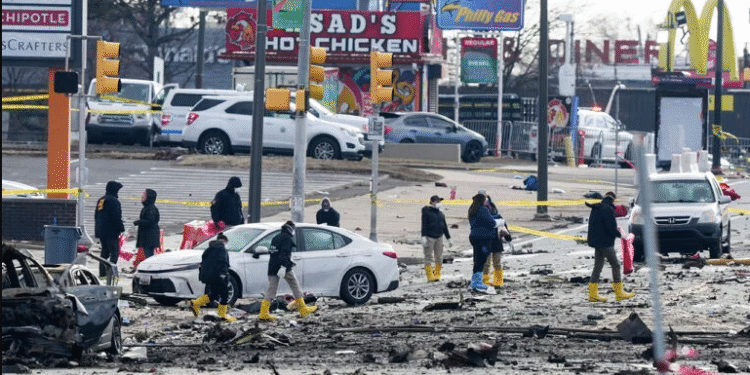The term “Philly plane crash” evokes a sense of deep sorrow and shock, as the city of Philadelphia and its surrounding communities grapple with the aftermath of such a tragic incident. Plane crashes are one of the most harrowing events that can occur, and when they happen in or near a major city, the impact is felt not only by the families and friends of the victims but also by the entire community. This article will delve into the details of notable plane crashes near Philadelphia, analyze the causes, and explore the broader implications of such accidents.
The Tragic History of Plane Crashes in Philadelphia

Philadelphia, one of the largest and most important cities in the United States, has witnessed its fair share of aviation accidents. Among the most notable of these is the crash of American Airlines Flight 587 on November 12, 2001. This tragedy took place just minutes after takeoff from John F. Kennedy International Airport in New York, but its proximity to Philadelphia and the impact it had on the region left an indelible mark.
American Airlines Flight 587 was en route to the Dominican Republic when it crashed into the Belle Harbor neighborhood of Queens, New York, killing all 260 people aboard and five people on the ground. While this crash occurred in New York, many Philadelphians were affected by the tragedy, given the region’s close ties to the New York metro area. This disaster, along with other regional crashes, heightened awareness of aviation safety and led to a more rigorous focus on improving flight protocols, pilot training, and airline maintenance practices.
Another infamous event that shook Philadelphia occurred on March 3, 1974, when a DC-10 operated by Turkish Airlines crashed during its final approach to the Philadelphia International Airport. The aircraft was en route from Istanbul and had just entered the final stages of its descent. Tragically, all 346 people on board perished. The crash was caused by the failure of the aircraft’s cargo door during flight, leading to catastrophic cabin depressurization and a rapid loss of control.
Such incidents are painful reminders of the risks inherent in aviation and the need for constant improvements in technology, safety regulations, and emergency response systems.
Understanding the Causes of Plane Crashes

While aviation has become one of the safest modes of transportation, the occasional crash still occurs, often due to a combination of factors. In the case of Philadelphia plane crashes, the causes often involve human error, mechanical failure, weather conditions, or a combination of all three. Let’s examine some of the most common causes of plane crashes.
1. Human Error
Human error remains one of the leading causes of aviation accidents. Pilot mistakes, miscommunications between the cockpit and ground control, and errors in judgment can all contribute to fatal accidents. For example, poor decisions made by pilots or air traffic controllers during crucial moments of flight can lead to disastrous outcomes. Training, experience, and a clear understanding of flight protocols are critical in minimizing the risk of human error.
2. Mechanical Failure
Another significant factor in aviation accidents is mechanical failure. Aircraft are incredibly complex machines, and sometimes, mechanical problems that cannot be detected or prevented in routine maintenance can lead to disaster. Engine failure, malfunctioning control systems, or failure of vital parts like landing gear or avionics can cause a plane to crash. This emphasizes the importance of rigorous safety checks and technological advancements to prevent such failures.
3. Weather Conditions
Severe weather can also play a pivotal role in aviation accidents. Thunderstorms, fog, high winds, and low visibility can compromise a pilot’s ability to navigate and land an aircraft safely. Even the most experienced pilots can struggle to maintain control when faced with extreme weather conditions. Additionally, poor weather can also affect the functionality of aircraft instruments and create dangerous turbulence.
4. Bird Strikes
One unique risk to aviation, especially in heavily populated areas like Philadelphia, is bird strikes. Birds can collide with aircraft during takeoff or landing, leading to engine damage or even total engine failure. The risk of bird strikes is especially high near airports, where large concentrations of birds are common. Airports around Philadelphia, such as Philadelphia International Airport (PHL), take measures to mitigate this risk by using radar technology to track bird movements and employing other strategies to prevent accidents.
Impact on the Community
The emotional toll of a plane crash extends far beyond the immediate families of the victims. The entire community feels the loss, particularly when a disaster occurs in a densely populated area like Philadelphia. The city’s residents may know someone who was on the plane or have a direct connection to the victims. Additionally, such tragedies often lead to a ripple effect in the community’s mental and emotional well-being.
In Philadelphia, as in other cities, aviation accidents spark conversations about safety protocols and the improvements needed to prevent future tragedies. The city also plays a crucial role in supporting the victims’ families through memorials, fundraisers, and counseling services. For many, the shared grief and solidarity during such times serve as reminders of the fragility of life and the importance of supporting one another in times of crisis.
Advances in Aviation Safety
Following each plane crash, investigations are launched to determine the root cause of the incident. These investigations are typically conducted by agencies such as the National Transportation Safety Board (NTSB), which works to uncover what went wrong and prevent similar accidents from occurring in the future.
In the years following the 9/11 attacks, aviation safety took a sharp turn toward higher standards. The tragedy of American Airlines Flight 587, for example, prompted changes to the airline industry’s policies, specifically regarding pilot training, emergency procedures, and cockpit security. Technological advancements have also contributed to the safer operation of planes. Modern aircraft are now equipped with advanced avionics, weather radar systems, and collision avoidance systems that were not available in the past.
Moreover, improved air traffic control systems have helped reduce the likelihood of mid-air collisions and pilot errors. The introduction of automation systems, such as autopilot, has reduced human error but also required pilots to undergo more intensive training to ensure they can take control of the plane when necessary. These advancements have made flying significantly safer, but aviation authorities continue to monitor and address any emerging threats.
Preparing for the Worst: Emergency Response and Recovery
Although plane crashes are rare, being prepared for the worst is essential for both aviation professionals and emergency response teams. Philadelphia, with its proximity to one of the busiest airports on the East Coast, has developed highly effective emergency response protocols to handle large-scale aviation accidents. The Philadelphia Fire Department and emergency medical teams have specific plans for handling aviation disasters, which include rapid response times, search and rescue operations, and victim identification.
Additionally, many communities affected by aviation disasters receive psychological support through specialized counseling programs. Mental health professionals help survivors, witnesses, and first responders cope with the trauma of such events. These programs are vital in aiding recovery and providing individuals with the tools they need to heal after experiencing a devastating loss.
Conclusion
The memory of a Philly plane crash, whether it occurs within the city or on its outskirts, remains a somber reminder of the complexities and dangers of aviation. While the cause of such tragedies may vary, the emotional and societal effects are universally felt. However, each crash also serves as an opportunity for growth, learning, and improvement in the aviation industry.
By prioritizing safety measures, investing in technology, and continuously training pilots and emergency responders, the risk of future plane crashes can be minimized. As a community, Philadelphia remains committed to supporting those affected by aviation accidents and striving for safer skies.


















